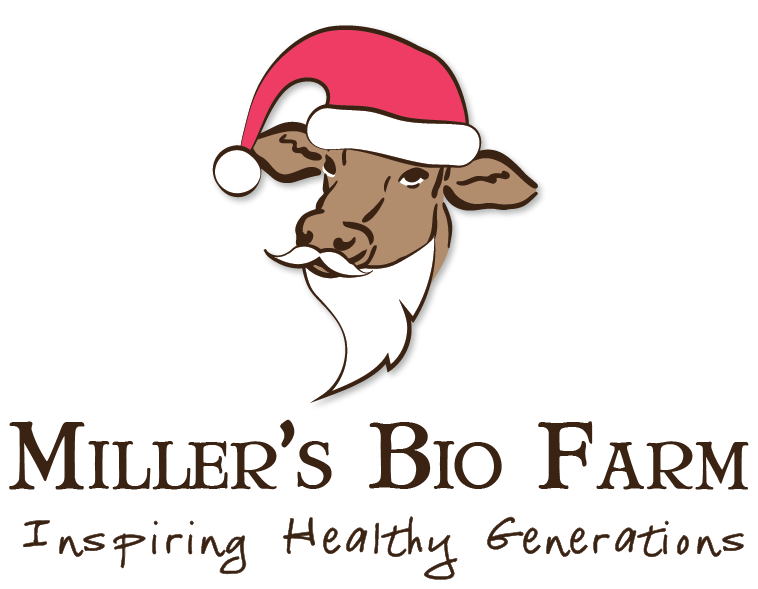Minute details for this year's on demand turkeys
posted on
September 17, 2024

*Originally written in September 2020. Updated in September 2025.
Bear with me. I have a bunch of interesting turkey details to share with you.
Our turkeys are sold on demand! That means you order one when you need one. No preorders. No hoops.
Fall turkeys will start going to the processor in October and will continue to be sent through November. That means that you can start ordering whole turkeys soon!
Here are the basics - Our turkeys are a “white” breed, live on green pasture, and are naturally raised and processed.
Once they are a couple weeks old and can tolerate chilly nights, our turkeys live 100% on green pasture. They are moved daily so the pasture stays fresh, and they leave behind wonderfully fertilized soil.
In addition to what they can forage, the turkeys eat a soy-free, corn-free, and GMO-free feed (a lot more on that below). They aren’t given hormones or antibiotics.
When processed, we don’t add any junk in our turkeys. They aren’t injected with artificial flavors, colors, preservatives, tenderizers, or anything synthetic.
I am always wanting to find out more about how my food was produced. So, I’m diving deep to answer the question, “What’s in the feed?”
I mean, I know the feed ingredients, but where do they come from? How are they produced? Why are they needed? To find out, I called our feed supplier, Vernon from Panorama Organic in Berks County, PA. Here’s what I found out.
The turkey feed is specially formulated blend of wheat, field peas or lentils, flaxseed and flaxseed oil, barley, fishmeal, kelp, molasses, and a nutri-balancer. Vernon works with Fertrell, the organic mineral supplier, to figure out the best blend.
Fertrell uses computer models to analyze feed mixes for optimal nutrition based on protein, energy, metabolism, etc. Then, Vernon makes small changes based on what he sees first hand - what’s working and what’s not working. Vernon is both a farmer and a feed supplier. This process is constantly happening. He’s always supplying the best feed possible.
100% of the ingredients in the feed are grown in the US or comes from the Atlantic Ocean. That’s pretty neat!
Here are some notes on the feed components:
Wheat (20%) - When compared to corn, wheat is higher in protein, amino acids, and energy content. The gluten in the wheat helps the feed bind together in naturally forming pellets. The wheat is sourced locally as much as possible. When local, we know the farmer and that it's "grown organically". If bought in from a distributor, we always buy “certified organic”.
Field peas or lentils (40%) - Peas and lentils are a good protein and energy source and are often used as a soy replacer in feeds. But, you can’t feed too much otherwise you may have issues with digestion. These are “certified organic” and come from North Dakota, South Dakota, or Montana. Sometimes Vernon buys direct from farmers he knows and sometimes he uses a broker like Organic Valley Brokering.
Flaxseed and flaxseed oil (20%) - Flax is one of the most concentrated sources of unsaturated fatty acids and results in a healthier fat profile in the turkeys. Feeding flaxseed results in a huge increase in omega-3 fatty acids, especially in the white meat. The flaxseed and flax oil is grown and sourced with the same standard as the peas and lentils (above).
Barley - This is used sparingly, because too much can make sticky droppings. It provides energy but is mainly used for its fatty acids. Barley contains twice the amount of fatty acids as wheat. This all comes from local PA farms within 20 miles of the mill. It is either “certified organic” or “grown organically”.
Fishmeal - The fish meal is used in the ration both as a great source of protein and amino acids, but also because it attracts the birds to their feed and actually helps them digest it better. The fishmeal is sourced from Fertrell. It is a 100% whole sardine meal that is wild-caught off the coast of South America. The fishery has a sustainability certificate so they only harvest what they can take to sustainably keep the fish population going for the future. They use mixed tocopherols as the preservative (the only preservative allowed under organic regulations) and never use Ethoxyquin.
Kelp - This is an excellent and natural source of vitamins and minerals. It boosts the turkeys’ immune systems, bone health, and overall well-being. The kelp comes from Fertrell. It is Acadian kelp, harvested off the northern US and Canadian coasts.
Molasses - Molasses is added for flavor and minerals but mostly because it settles the dust created by the feed. Just a little molasses is added, about 15 lb per ton of feed. The molasses comes from Honey Brook, PA. It is “certified organic”.
Nutri-balancer - This comes from Fertrell and is called the “poultry pre-mix”. It gives extra vitamins and minerals and also helps the birds metabolize. It contains ingredients like calcium, phosphorus, vitamin A, salt, and lactic acid bacteria and a bunch of other bacterias.
Once all the feed ingredients are sourced, Panorama Organic grinds the feed in its mill or Vernon’s nephew’s nearby mill. Nowadays this kind of local craft milling is extremely unique.
In Vernon’s area, there used to be mills on every other street corner. But then the “Walmart effect” came into agriculture. Now there are mega mills that small farmers and small mills cannot compete with. It’s just one more reason that high quality nutrient-dense food costs more.
I personally am so thankful for farmers like Aaron from Miller’s Bio Farm and Vernon from Panorama Organic. My family owes its health to them.




